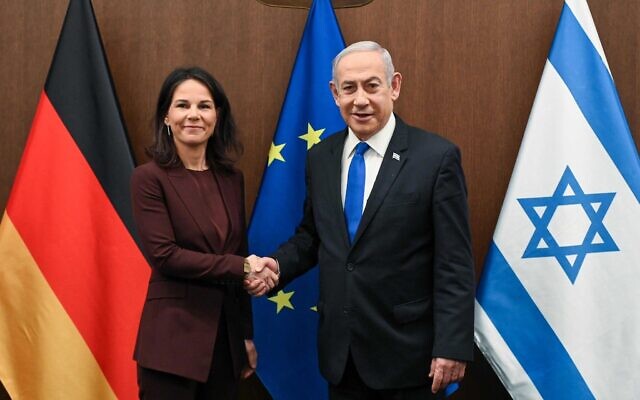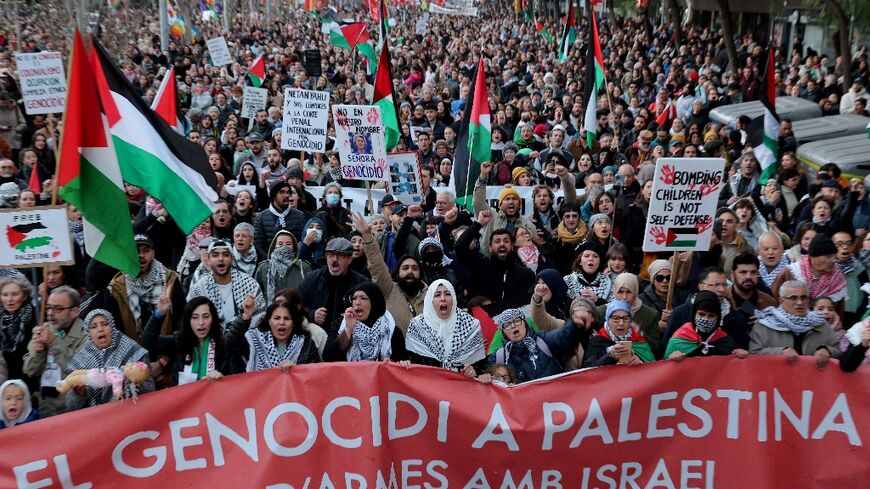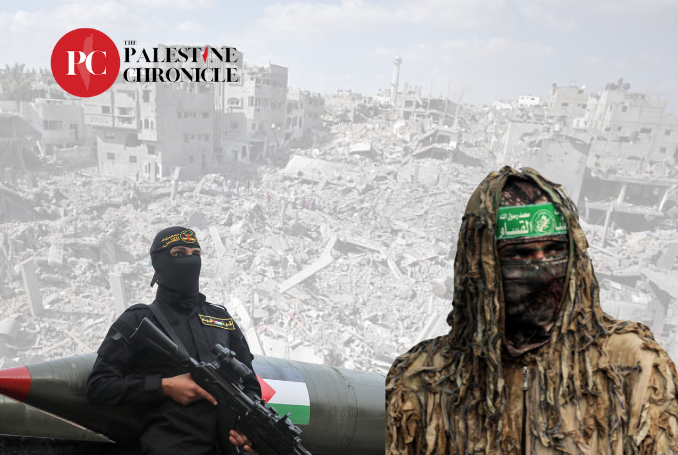
Barcelona Haggadah (14th century),
Jews departing synagogue
(credit: modia.org)
Historical Background:
In this current age of venomous Arab-Jewish relations, it is easy to forget that there once was another age in which Jews and Arabs lived together in cultural, political & social harmony. During medieval Spain’s Golden Age, Jews played prominent roles in politics, art, commerce and all major areas of social discourse side by side with their Muslim brothers and sisters. Jews and Muslims did not hate each other’s religion as many appear to today. On the contrary, their respective theologians learned from each other & used the wisdom learned to enrich their own religion’s discourse.
Jews were prominent advisors to Arab leaders. They were the financiers who helped the viziers run the great Spanish cities of Toledo, Seville and Granada. Jewish poets (Yehuda HaLevi, Shlomo Ibn Gabirol, Abraham Ibn Ezra) wrote some of the finest poetry from this region & historical era. In their poetry, they describe the great culinary feasts at which both Arab & Jewish poets & musicians entertained guests with their elegant & cosmopolitan artistic productions.
Only in 1492, with the rise to power of Spain’s Christian monarchs, Ferdinand & Isabella, did the Golden Age come to an abrupt end with the Expulsion of the Jews. With the Inquisition that followed, Christian Spain hounded, harassed and tortured the remaining secret Jews (Marranos) instituting one of history’s most hateful periods of Jewish persecution (until the Holocaust).
The end of the Golden Age and the exile of Spain’s Jews was not the end of a Jewish life in Arab lands. Jews have lived throughout the Mediterranean region since well before the time of Jesus and up to the present day. Many of the lands they lived in were Arab (Egypt, Tunisia, Algeria, Morocco, Turkey, Yemen and Bosnia). And in each of these places, Jews largely lived in peace with their neighbors. Indeed, they made extraordinary intellectual contributions to their societies. Both Jewish & Arab philosophers & scientists helped preserve Greek & Roman texts by translating them into Arabic. Without their work, many of the great Greek & Roman thinkers would be unknown to us today. Such cultural cross-pollination continued unabated until the creation of the State of Israel in 1948. This event unfortunately helped sour relations between Arabs and Jews and led hundreds of thousands of Sephardic Jews to leave their ancestral homelands in places like Morocco, Yemen and Iraq for Israel.
Maimonides (Moshe ben Maimon) was one of the world’s greatest philosopher-scientist-theologian, who lived in 13th century Egypt. He translated & preserved ancient texts, codified the entire Jewish halacha (a legal system like Muslim sharia) in redactions that provided the basis for all subsequent Jewish legal discourse, and he engaged in serious medical and scientific research as well. In addition to his contribution to Jewish thought, he was an eminent physician, whose practice treated both Jews & Arabs patients without regard to religion.
So before today’s Arabs & Jews jump to the worst possible conclusions about each other; before they assume that the other wishes them dead and has always done so; before they lift their hands to slay the other in hatred; each group should remember that there once was a time when they together were a beacon of hope & learning to the world. And if there once was such a time; then there can (and will) be such a time again.
Sephardic Music and Hesperion XXI:
Many recordings capture the wonder of Jewish music in Arab lands. Perhaps the best-known exponent of this music is Hesperion XXI, formed in the early 1970s by students at the Schola Cantorum Basiliensis in Switzerland led by Jordi Savall. As a Spaniard, he became interested in medieval Spanish musical traditions and formed the group, naming it after the Greek word for the Iberian peninsula, Hespera or “West.” Its Secular Music of Christian & Jewish Spain: 1450-1550 (Virgin veritas x 2) is one of the fine early recordings in the field. It was first released in 1976 with brilliant liner notes by Professors Israel Katz, Joseph Silverman and Samuel Armistead (all quotations that follow are from these notes) that give a complete & comprehensive overview of not only the music on the recording, but all of Sephardic musical tradition. Unfortunately, the original recording is out of print and its liner notes unavailable (unless you’re lucky enough to own it). The Virgin reissue has execrable liner notes.
Its Secular Music of Christian & Jewish Spain: 1450-1550 (Virgin veritas x 2) is one of the fine early recordings in the field. It was first released in 1976 with brilliant liner notes by Professors Israel Katz, Joseph Silverman and Samuel Armistead (all quotations that follow are from these notes) that give a complete & comprehensive overview of not only the music on the recording, but all of Sephardic musical tradition. Unfortunately, the original recording is out of print and its liner notes unavailable (unless you’re lucky enough to own it). The Virgin reissue has execrable liner notes.
Jews first came to Spain in the first millennium B.C.E. along with Phoenician traders. “Throughout the centuries, the Jewish population…evolved from the first small communities to sizeable populations in the major cities and indeed, they contributed to the mainstream of Hispanic culture already in the Visigothic era, but particularly during their participation, with their Christian and Moslem neighbors, in the great religious and cultural symbiosis of the Spanish Middle Ages.”
The recording’s title is misleading considering that the Jewish music covered on the album really derives from post-1492 (post-Expulsion) Jewish musical traditions in countries throughout the Mediterranean basin. In fact, there is no known piece of music that can authenticated as written before the Expulsion. We only have versions of these songs that derive from Sephardic communities in the 17th, 18th and 19th centuries. So the notion of a canon of authentic medieval Spanish Jewish music is false. We assume, but cannot prove decisively that these later songs have their roots in, and are closey related to medieval Spanish Jewish musical tradition.
Hesperion chose the twelve musical pieces on this recording from Isaac Levy’s Chants Judeo-Espanols (London-Jerusalem, 1953-1973). “Their aim has been to provide a proper context for the performance of the chosen melodies and texts, one which would coincide with musical practices prior to the Expulsion. The result…is a sincere attempt to realize a performance practice…that was known to exist on the Peninsula…It would…be …incorrect to state that the tunes represent a pre-expulsion Hispanic tradition. They can only be regarded as representative of the tradition as it exists today: a rich amalgam of diverse cultural influences.” In other words, this music represents not just the musical experience of Jews in medieval Spain, but also the influences of every other Arab country they lived in subsequent to the Expulsion.
Recently, Hesperion XXI released Diaspora Sefardi (Alia Vox 9809), an account of Jewish music that focused on Arab lands of the eastern Mediterranean (Greece, Turkey, Iraq, Bosnia, etc.). Several songs here were also included on the earlier Secular Music recording, but there is new material as well. Last year, Hesperion toured the U.S., giving us an opportunity to hear the extraordinary musicianship of Savall & Montserrat Figueras, his wife & the group’s vocalist. Hers is a penetrating & resonant alto voice, which provides the listener with a lush musical experience. She “vividly displays the true characteristics of the native balladeer, adept at improvising around a skeletal melody, adding richly ornamented lines and embellishments from strophe to strophe.” A Sephardic musical scholar recently complained to me that Figeuras’ style was “aria-like,” saying that no Sephardic female singer would sing this way. This scholar finds her singing style and Hesperion’s approach to the music to be inauthentic. I will leave this debate to the scholars.
There are other worthy recordings which well represent the music of this period including . La Rondinella’s Sephardic Journey: Spain and the Spanish Jews and Songs of the Sephardim: Traditional Music of the Spanish Jews (Dorian 93171 and 80105). The latter contains one of my favorite (and one of the best known) Sephardic ballads, Los Bilbilicos:
The nightingales are singing
in the flowering tree.
Those who sit under the tree
are suffering from love.
The rose blooms
in the month of May
But my soul withers away
suffering from love.
Come more quickly, dove
more quickly come with me
Come more quickly, my love
run and save me.
As I listen to this glorious music, I tell myself: “Do not despair. The current hatred and violence cannot long prevail.” Mutual respect between the adherents of these two great faiths does not have to be long in coming if both would only remember and honor their own history.
There are several online references showcasing Hesperion XXI:
1. an interview with Jordi Savall in which he briefly talks about the differences between the two recordings reviewed here .
2. a comprehensive biography of Savall and detailed discography of Hesperion XXI and Savall.






The idyllic view of relations between Jews and Muslims generally fails to take into account that in medieval Muslim societies the Jews had a social and legal position that was far from being equal to that of Muslims. There never was a situation in which Jews and Muslims lived peacefully side by side on a basis of absolute equality. Also, at different places and in different periods of the history of Islam we obviously see a large variety of attitudes towards Jews and other non-Muslims ( and Muslims ) on the part of Muslim rulers. Some of these rulers were very tolerant, but it always was a tolerance that was a result of almost absolute superiority. Still, all this does not mean that we cannot learn from that period, or from each other. Some sort of ( separate? ) coexistence is still possible and should be our goal.
You make a good point in yr. comment. But I hope you realize that I wasn’t making the claim that Jews enjoyed absolutely equality with Muslims in this period. I also was not saying the period was an idyll. While Jews & Muslims may not have lived “peacefully side by side in absolute equality,” they did live peacefully side by side & that’s something important that neither Israelis nor Pal. have learned to do.
Plus, Muslims in this period & later were generally (note I did not say ‘absolutely’) more tolerant towards Jews than their Christian counterparts. I consider that a major distinction in the Muslims’ favor. There were probably as many problems bet. the religious groups in medieval Spain as there are in any society in which there are large religious minorities coexisting with another religious majority. My point was rather, despite such inequality Jews managed to play key roles within Spanish society, culture & the arts. They made major contributions to the society. That is the model I’d like to see within the contemporary ME.
As an artist and musician focussed on the period being discussed here, I can tell you that as it is today – the CULTURAL leaders – that is to say the musicians, artists, and writers, et al produced their work via collaboration and mutual inspiration. You see the evidence of this in how the same melodies can be found in notated musical works of both peoples and the illuminated scripts, crafts, decorative works, etc. shared common methods and motifs. Artists then, as now, were focussed on their work and collaboration and influence was, as it is now, vital to doing the work. You can’t devote yourself to the type of accomplishment required in the profession if you’re going to spend much of your time in a religious debate. As well, artsits, musicians, et al have always been outcasts struggling to make a living and by profession, much more devoted to the making of something than political and religious debate and battle. Religious institutions were a source of work for artists AND musicians and composers. Beyond that, as it is now, most artists and musicians had other priorities. I imagine that during the 14th century, things weren’t THAT much different for semitic artists and musicians as they were in the early 20th century where in order to work for example as a musician, it wasn’t unheard of to disguise one’s self and pretend he was not a Jew or not a Muslim or not a gypsy in order to get a particular ‘gig’. Bands were comprised of a true mix of backgrounds as far as the musicians were concerned and the makers of culture were then as today and not by preference more concerned about survival than the nature of the God that their benefactor prayed to.
Thanks for yr comment LjR.
I do think we have to be careful when we study cultures outside our own. In doing so, we sometimes can project our own values and beliefs onto the subject we’re studying. I think you’ve done this in yr comment.
There is no way one can minimize the critical nature of religion in the cultural and artistic phenomenon that is the Golden Age. The “nature of God” was a critical factor for both Jews and Muslims in everything they did including their art, music and literature. If you attempt to diminish the role of religion you make a mistake that does not help you understand what you are studying.
I can hear in yr comment the tremendous respect you have for medieval Spanish culture. That’s certainly a wonderful thing. But we must try respect a culture more on ITS terms and less on our own.
Since when is Bosnia Arab?
Muslim. I wrote this piece a long time ago. If I wrote Arab I should’ve written Muslim.